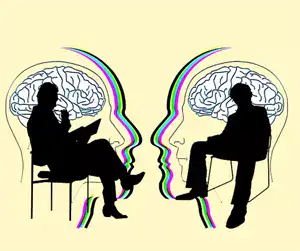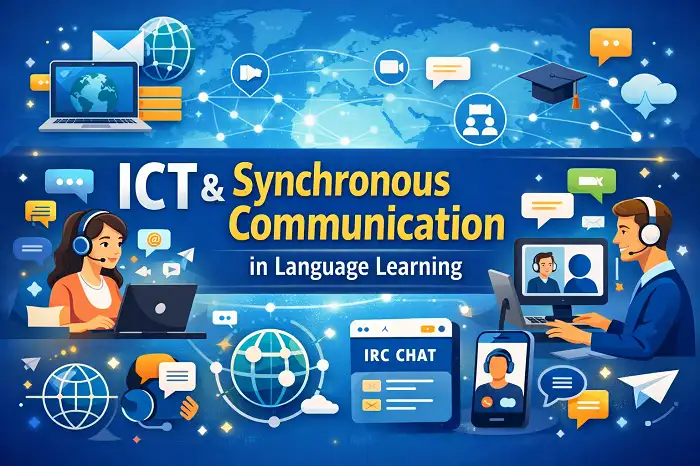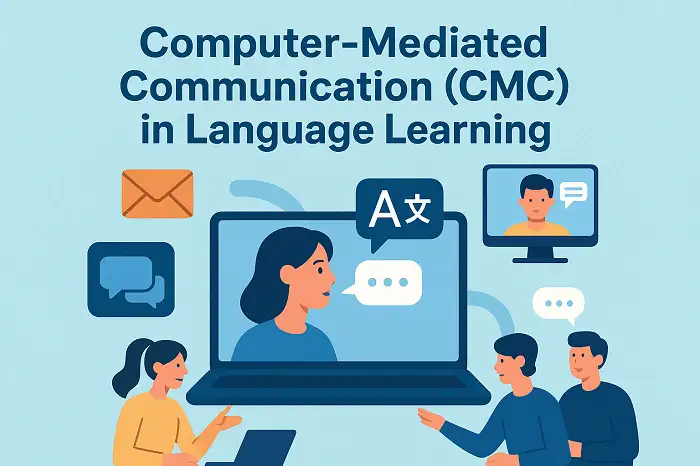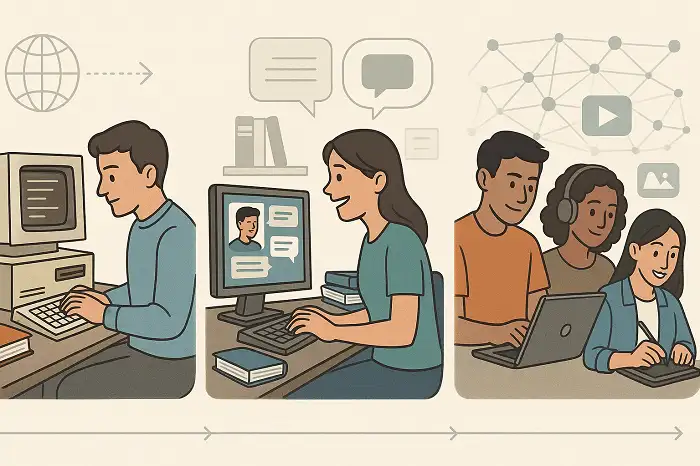Table of Contents
- Video of interactive negotiation of meaning
- Abstract
- Background
- Interaction Hypothesis
- Genuine communication
- Communication strategies
- Negotiation of meaning
- Negotiation of form
- Interactional adjustment
- Interactional negotiation
- Focus on Form
- Information gap tasks
- Problem-solving activities
- Criticism
- Conclusion
- References
- How to cite this article in APA Style?
Interactive negotiation of meaning and form in ESL classes written by Dr. Mohammad Hossein Hariri Asl
Author: Dr. Mohammad Hossein Hariri Asl
Video of interactive negotiation of meaning
Abstract
Second language learning and teaching cannot be taken for granted, and it cannot take place in a vacuum. From the advent of Communicative Language Teaching (CLT) in the 1970s, more emphasis has been placed on the interaction between the teacher and the learners, and among the learners themselves. It is believed that input per se is not sufficient to give rise to competency in SLA. Instead, both input and interaction are necessary to achieve this goal. The current study was conducted to explore the effect on negotiation of meaning and form on the level of achievement and success in SLA. It is alleged that negotiation of meaning and form together with ‘focus on form’ can turn out to be effective in helping the L2 learners to get involved in information-gap processing and problem-solving activities with an equal emphasis on both form and function in the class.
Background

Historically, in naturalistic classrooms, negotiation of meaning (N/M) has assumed to take an active role in learner– learner interaction (Foster & Ohta, 2005). The central concept in the interaction approach is ‘negotiation of meaning’ – “the process in which, in an effort to communicate, learners and competent speakers provide and interpret signals of their own and their interlocutor’s perceived comprehension” (Long, 1996, p. 428, as cited in Cook, 2008).
In other words, useful interaction involves keeping the conversation rolling by continuously resolving any difficulties in comprehension. Some of the different possibilities are: “repetitions, confirmations, reformulations, comprehension checks, clarification requests, etc.” (Long, 1996, p. 418, as cited in Cook, 2008).
Interaction Hypothesis
The interaction hypothesis is a development of the input hypothesis (Long, 1985, as cited in Davies & Elder, 2006). The prerequisite for learning is still seen as comprehensible input, but attention is now drawn to the conditions that enable comprehensible input to be made available. The hypothesis argues that this is most likely to occur in situations of social interaction. These provide opportunities for the negotiation of meaning, requests for clarification, and comprehension checks.
Most teachers would agree that there is a need for communication that balances teacher-led instruction with group work and learner-to-learner, or peer, interaction (Pica, 2000). According to Barkhuizen and Ellis (2005), the study of the negotiation of meaning has been closely linked to Long’s Interaction Hypothesis (IH). This drew on Hatch’s (1978, as cited in Barkhuizen & Ellis, 2005) key insight that learners are able to learn a second language through the process of interacting rather than just manifesting what they have already learnt in interaction. It seems to be important to distinguish early and late versions of the Interaction Hypothesis.

Interaction among peers, however, does not always run smoothly (Cohen, 1986, Cohen & Lotan, 1997; Foster, 1998; Foster & Ohta, 2005, as cited in Van den Branden, 2006). Problems that often arise in group interaction have to do with domination, non-involvement and, consequently, non-participation, the ‘free rider effect’ (one pupil does all the hard work while the others profit), the diffusion of responsibility (some pupils are simply ignored, their ideas are not taken into consideration, while pupils with a higher status do not bother to explain what is happening and the absence of interactional processes, such as the negotiation of meaning, that are believed to foster language acquisition.
The early version of the IH was closely associated with the Input Hypothesis (Krashen, 1985, as cited in Barkhuizen & Ellis, 2005). This claims that learners will acquire an L2 when they have access to comprehensible input and when their ‘affective filter’ is low so that the comprehended input is made available to the internal acquisitional mechanisms for processing.
The later version of the IH went some way towards addressing some criticisms against the early version. Long’s (1996, as cited in Barkhuizen & Ellis, 2005) updated IH emphasized that the role of negotiation is to facilitate the kinds of conscious noticing that Schmidt (1990, 1994, as cited in Barkhuizen & Ellis, 2005) has argued is required in order for learners to process input for intake. In this response, Long (1996, as cited in Barkhuizen & Ellis, 2005) argues:
…it is proposed that environmental contributions to acquisition are mediated by selective attention and the learner’s developing L2 processing capacity, and that these resources are brought together more usefully, although not exclusively, during ‘negotiation for meaning’ (p. 414).
In both versions of IH, the negotiation of meaning is the central discourse construct. Both versions also emphasize that interaction involving meaning negotiation only facilitates acquisition; it does not cause acquisition to take place. In other words, modified interaction can only “set the scene for potential learning” (Gass, Mackey & Pica, 1998, as cited in Barkhuizen & Ellis, 2005, p. 304).
Long’s (1996, as cited in Ellis, 2008) updated IH, which emphasized that the role of negotiation is to facilitate ‘attention’ to form, argues that:
…negotiation for meaning, and especially negotiation work that triggers interactional adjustments by the NS or more competent interlocutor, facilitates acquisition because it connects input, internal learner capacities, particularly selective attention, and output in productive ways (pp. 451-452).
In contrast to the early version of the IH, which simply postulated an effect for comprehensible input, the later version sought to account for how interactionally modified input contributes to acquisition by specifying the learner internal mechanisms involved. Interactionally modified input works for acquisition when (1) it assists learners to notice linguistic forms in the input and (2) the forms that are noticed lie within the learner’s processing capacity (Ellis, 2008).

According to Ellis (2008), the updated version of the IH also afforded a much richer view of how negotiation can assist language learning. As in the early version, negotiation was seen as providing learners with comprehensible input, thereby supplying them with positive evidence.
From a psycholinguistic point of view, second language interaction is mainly interesting because of the opportunities it seems to offer to individual second language learners, to fine-tune the language input they are receiving. This ensures that the input is well adapted to their internal needs, i.e. to the present state of development of their second language knowledge (Mitchell & Myles, 2004).
Following on Long’s original studies, many others drew on the Interaction Hypothesis and used a similar taxonomy of conversational moves to track meaning negotiations and conversational repair. These are usefully reviewed by Larsen-Freeman and Long (1991) and Pica (1994, as cited in Mitchell & Myles, 2004). On the whole, these studies followed designs similar to that of Long (1980, as cited in Mitchell & Myles, 2004), tracking pairs of native and non-native speakers in various combinations, undertaking a variety of semi-controlled conversational tasks.
Long’s (1996, as cited in de la Fuente, 2002) updated version of the interaction hypothesis states that “negotiation of meaning . . . facilitates acquisition because it connects input, internal learner capabilities, particularly selective attention, and output in productive ways” (pp. 451–452). Long (1996, as cited in de la Fuente, 2002) suggests that, in terms of internalizing interaction, there is a role for negotiated interaction that elicits negative feedback, which may induce noticing of some forms (p. 414).
Genuine communication
Nunan (1987, as cited in Seedhouse, 1996) states:
Genuine communication is characterized by the uneven distribution of information, the negotiation of meaning (through, for example, clarification requests and confirmation checks), topic nomination and negotiation by more than one speaker, and the right of interlocutors to decide whether to contribute to an interaction or not. In other words, in genuine communication, decisions about who says what to whom and when are up for grabs (p. 137).
Communication strategies
Second language learners have to attend to many unpredictable, changing features of a dynamically complex communicative environment. The input to the L2 user can be a critical factor in shaping the way the individual engages in the “negotiation of meaning” (Long, 1996, as cited in Doughty & Long, 2003). Second language communication requires one to draw on linguistic knowledge and various cognitive strategies in order to meet immediate communicative needs, just as in the case of complex simulation games.
Negotiation of meaning

Long’s interaction hypothesis emphasizes the importance of comprehensible input but claims that it is more effective when it is modified through the negotiation of meaning (Ellis, 1997). Learners often receive ‘negative evidence’. That is, their interlocutors indicate when they have not understood and, in the course of so doing, may model the correct target-language forms. Thus, learners receive input relevant to aspects of grammar that they have not yet fully managed.
Checking and clarifying problem utterances (negotiating for meaning) ensures that task participants receive comprehensible input and generate comprehensible output, both of which have been claimed as crucial to SLA (Foster, 1998).
Jepson (2005, as cited in Bailey & Nunan, 2009) defines negotiation of meaning as “a cognitive process that speakers use to better understand one another, that is, to increase the comprehensibility of language input” (p. 79).
According to Pica (1991), there is a need for longitudinal studies which reveal how learners evolve into better comprehenders through classroom interaction and negotiation of meaning. Longitudinal studies may show how, as learners become better comprehenders of L2 input, they can become more versatile in their approach to comprehension tasks.

Pica (1992, as cited in Ellis, 2008) illustrated how the negotiation of meaning provides learners with information about the semantic and structural properties of the target language. Native speakers respond to non-native speakers’ triggers by modifying their utterances semantically and/or formally through the segmentation and movement of input constituents.
Mackey and Philp (1998, as cited in de la Fuente, 2002) believe that negotiation of meaning seldom involves grammar, but rather phonological and lexical aspects: “when phonological and lexical feedback is provided in interaction, [learners] are more likely to perceive it correctly” (p. 494).
Negotiation of form
Findings indicate that lexical errors favored the negotiation of form; grammatical and phonological errors invited recasts, but with differential effects in terms of learner repair. Overall, the negotiation of form proved more effective at leading to immediate repair than did recasts or explicit correction, particularly for lexical and grammatical errors, but not for phonological errors. Phonological repairs resulted primarily from recasts (Lyster, 1998).
The term, negotiation of form, is considered to be more accurate than negotiation of meaning in the ways in which teachers focused on form during meaningful interaction (Lyster, 1994, as cited in Lyster, 1998). In contrast to the latter’s primarily conversational function, “aimed to resolve communication breakdowns and to work toward mutual comprehension” (Pica, 1989, p. 65, as cited in Lyster, 1998), we attributed to the negotiation of form a more didactic function: namely, “the provision of corrective feedback that encourages self-repair involving accuracy and precision and not merely comprehensibility” (Lyster & Ranta, 1997, p. 42, as cited in Lyster, 1998).
We concluded that the negotiation of form provided learners with timely opportunities to make important form-function links in the target language without interrupting the flow of communication and while maintaining the mutuality inherent in negotiation. That is, when teachers used either metalinguistic clues, elicitation, repetition of error, or clarification requests, they returned the floor to students along with cues for the latter to draw on their own resources, thus allowing for negotiation to occur bilaterally. Conversely, there appeared to be little to negotiate between teacher and student when the teacher provided either recasts or explicit corrections.
Interactional adjustment

According to Long (1985, 1996, as cited in Foster & Ohta, 2005) the most valuable way in which input is made comprehensible is through interactional adjustments. These are the attempts of learners and their conversation partners to overcome comprehension difficulties so that incomprehensible or partly comprehensible input becomes comprehensible through negotiating meaning. In these negotiations, problem utterances are checked, repeated, clarified, or modified in some way (lexically, phonologically, morphosyntactically) so that they are brought within the optimum I + 1 level.
The value in these negotiations, especially in group work, is that they can provide I + 1 input which is made to measure for individual learners and their current interlanguage level. Moreover, they provide learners with negative evidence about their own output, and push them to modify it to make it more comprehensible and more target-like (Swain, 1985, as cited in Foster & Ohta, 2005).
Among the most productive tasks for SLA are those in which interaction must lead to a specific goal or outcome, and reaching this outcome requires a verbal exchange of information (e.g., R. Ellis, 2003; Pica, Kanagy & Falodun, 1993, as cited in Hyun-Sook, Pica & Sauro, 2006). Such tasks set up conditions for participants to modify their interaction through the negotiation of meaning (Long, 1980; Varonis & Gass, 1985, as cited in Pica et al., 2006). As learners repeat and rephrase utterances to make sure that their information is accurate and understood, they also draw attention to the forms that encode these utterances.
Interactional negotiation
Typically, in studying NS-NNS interactions, interactional negotiation moves such as confirmation and clarification requests have been counted across both NS and NNS interactants, but the thrust of the analysis has been on the role served by these interactional moves in making NS production become comprehensible input to the NNS. NNS production has been seen primarily as a trigger for the NS to initiate a move toward modifying the interaction, providing comprehensible input, and achieving mutual comprehension with the NNS (Long, 1980, 1983; Pica, Doughty & Young, 1986; Pica, Young & Doughty, 1986, as cited in Pica, 1994).
The term interaction is used restrictively to refer to a particular type of interaction in which negotiation of meaning is involved. The need for negotiation of meaning arises when participants in an interactional activity try either to prevent a potential communication breakdown or to repair an actual communication breakdown that has already occurred (Kumaravadivelu, 2003).
Other SLA theories have drawn on the theories of Vygotsky, a Russian psychologist, to explain how interaction serves as the bedrock of acquisition. The two key constructs in what is known as ‘activity theory’, based on Vygotsky’s ideas, are ‘motive’ and ‘internalization’. The first concerns the active way in which individuals define the goals of an activity for themselves by deciding what to attend to and what not to attend to. The second concerns how a novice comes to solve a problem with the assistance of an ‘expert’, who provides ‘scaffolding’, and then internalizes the solution (Ellis, 1997). In this respect, the notion of the zone of proximal development (ZPD) is important.
Kumaravadivelu (2006) considers ‘negotiated interaction’ as a macrostrategy. This macrostrategy refers to meaningful learner–learner, learner–teacher interaction in class where the learners have the freedom and flexibility to initiate and navigate talk, not just react and respond to it. In this response, Kumaravadivelu (2006) argues:
Negotiated interaction means that the learner should be actively involved in interaction as a textual activity, interaction as an interpersonal activity and interaction as an ideational activity. During these interactional activities, teachers should facilitate the learner’s understanding and use of language as system, language as discourse, and language as ideology (p. 202).
He (2006) further adds that there is overwhelming evidence to suggest that L2 learners need to be provided with opportunities for negotiated interaction in order to accelerate their comprehension and production. Studies on interactional modifications demonstrate that what enables learners to move beyond their current receptive and expressive capacities are opportunities to modify and restructure their interaction with their interlocutors until mutual comprehension is reached.

In the context of negotiation of meaning, Long (1996, as cited in Kumaravadivelu, 2003) makes a distinction between modified input and modified interaction. The former involves modifications of language input that has short phrases and sentences, fewer embeddings, and greater repetition of nouns and verbs, while the latter involves modifications of the conversational structure that has a considerable number of comprehension checks, confirmation checks, and clarification requests.
A comprehension check is the speaker’s way of finding out whether the hearer has understood what was said (“Do you understand me?” or “Do you follow me?”). A confirmation check is the speaker’s way of verifying whether his or her understanding of the hearer’s meaning is correct (“Is this what you mean?” or “Are you saying you did go to Disneyland?”). A clarification request is a request for further information or help in understanding something that has been said (“Can you say that again?” or “Huh?”).
Although interactional modifications do occur in day-to-day conversations among native speakers of a language, studies show (Gass, 1997, as cited in Kumaravadivelu, 2003) that they occur to a greater degree in conversations involving speakers with unequal language competence, such as between native speakers and non–native speakers, or non–native speakers-non–native speakers (NNS-NNS) of different proficiency levels.
Focus on Form

In a study, Lightbown and Spada (1990, as cited in Kumaravadivelu, 2006) investigated the effects of form-focused instruction and corrective feedback in communicative language teaching. Their study was part of a long-term project and the data came from more than a 1000 students in nearly 40 intensive ESL classes and from over 200 students in regular ESL programs.
The instructional strategy consisted of meaning-based activities, opportunities for the negotiation of meaning in group work, and the provision of comprehensible input. The teachers who taught these classes differed from each other in terms of the total amount of time they gave to form-focused activities. The researchers analyzed the learners’ listening and reading comprehension as well as their ability to speak.
They found that form-based instruction within a communicative context contributes to higher levels of language knowledge/ability. Lightbown and Spada (1990, as cited in Kumaravadivelu, 2006) concluded that “accuracy, fluency, and overall communicative skills are probably best developed through instruction that is primarily meaning-based but in which guidance is provided through timely form-focused activities and correction in context” (p.443).
Information gap tasks
Information gap tasks have been the focus of comparison studies on learners’ negotiation, collaboration, and encoding of form, function, and meaning for different tasks and classroom groupings. However, they have more commonly served as instruments for data collection in studies on classroom turn-taking, teacher versus student control of interactions, and group and pair participation patterns (Doughty & Pica, 1986; Duff, 1986; Kowal & Swain, 1994; Newton & Kennedy, 1996; Swain, 1998; Swain & Lapkin, 2001, as cited in Pica et al., 2006).
According to current second language acquisition theories, it is believed that learners can advance their receptive and expressive capacities in a second language if they obtain their interlocutor’s assistance in understanding linguistic materials not currently within their L2 repertoire (Pica, 1987).
Requests for assistance and clarification serve to restructure the interaction between the learner and interlocutor so that the meaning of unfamiliar linguistic materials contained within the interlocutor’s message can be repeated or reworded until the learner can understand it. It is believed, as a theoretical level, that such understanding is the foremost step towards incorporation of the new linguistic material into the learners emerging L2 system (Pica, 1987).
Classroom procedures of learner-centered pedagogy are largely woven around the sharing of information and the negotiation of meaning. This is true not only of oral communication activities, but also of reading and writing activities. As Kumaravadivelu (2006) has put it information-gap activities, which have the potential to carry elements of unpredictability, freedom of choice, and appropriate use of language, were found to be useful and relevant.
Problem-solving activities
Piatt and Brooks (1994, as cited in Mitchell & Myles, 2004) recorded pairs and groups of students undertaking a variety of communicative problem-solving tasks in second language classroom settings, and used activity theory to interpret the resulting discourse. The tasks included map-reading and jigsaw puzzle completion, that is, the sorts of activities which interaction theorists view as useful, because they supposedly promote the negotiation of meaning and the availability of comprehensible input, and hence provide rich opportunities for second language acquisition.

However, Piatt and Brooks argue that these tasks did not provide a uniform learning environment for participating learners, because different learners experienced them differently. They claim that students’ own immediate task-related goals are critical in influencing the nature of the activity as actually experienced.
Just and Carpenter (1992, as cited in Brooks & Kempe, 2006) have suggested that “the more representations, inferences, expectations, and problem-solving goals an individual is able to actively maintain, the better he or she is able to detect and compare patterns and relationships” (p. 189).
Criticism
Research has revealed that peer communication activities are not sufficient for meeting learner goals as far as L2 mastery is concerned. In the long run, students who engage in extensive student-to-student interaction, without the benefit of much direct interaction with their teacher, have been found to develop fluent, but non-target like production. This is largely because the input they receive from peer learners reinforces their own errors and misanalyses of the target language (Plann, 1977; Lightbown & Spada, 1990; White, 1990; Wong Fillmore, 1992, as cited in Pica, 2000).
The most obvious drawback to the interaction approach is that, while there is considerable research describing how interaction occurs, there is still little proof of its importance to second language learning rather than to second language comprehension, whether correction or recasts.
In this response, Foster (1998, as cited in Cook, 2008) believes that most students in the classroom would avoid making negotiation moves if they possibly could, perhaps because if exposed their ignorance in public. Undoubtedly, interaction helps some aspects of second language learning, but it is not clear how crucial this may be compared to all the other factors in the complex second language learning situation. According to Cook (2008):
Teachers’ interaction patterns are probably based on their experience and training, we do not know if there are better patterns they could adopt than these pre-existing patterns. Moreover, the analysis is usually based on interview-type data or classroom data involving a native speaker and a non-native student; hence, it is not representative of normal L2 usage in the world outside the classroom, which often takes place between L2 users (p. 227).
Long’s (1996, as cited in Lantolf, 2006) revised interactionist hypothesis, which recognizes that learning might occur in the absence of negotiation for meaning. The hypothesis integrates attention and processing capacity, which are “brought together most usefully, although not exclusively during negotiation for meaning” Long, p. 414, as cited in Lantolf, 2006).
While Lyster and his colleagues have focused on the salience of recasts for children, other researchers have questioned the value of other feedback types found in negotiation for meaning on children’s language development. For example, Van den Branden (1997, as cited in Mackey & Silvers, 2005) investigated whether (and to what extent) 48 native speakers (NSs) and non-native speakers (NNSs) of Dutch enrolled in the 5th grade of a Flemish primary school negotiated for meaning during a two-way picture-description task.
Although Van den Branden found that the children did negotiate for meaning and content and that this negotiation led to a greater quantity of output, a wider range of vocabulary, and more frequent mention of essential information in subsequent interactions, he also noted that “the negotiations had no significant effects on the syntactic complexity nor on the grammatical correctness of the learners’ output during the post-test” (Van den Branden, 1997, p. 589).
According to Johnson (2009), the language of the L2 classroom is often referred to as just that—classroom language, implying that it is fundamentally different from language in the everyday world. Some 30 years ago, CLT was conceptualized with the intention of transforming classroom language so that it would, in fact, mirror language in the everyday world.
Yet, as much published research has documented, even under the guise of CLT, especially in global contexts, other than adding a few novel instructional activities such as: information gap, role-play, task-based activities, etc., the language of the L2 classroom remains unlike language in the everyday world (Johnson, 2009).
In relation to the possibility of creating a classroom context that is close to the real-life situation, Widdowson (2003) argues:
The classroom contexts within which language has usually to be learnt are totally different from those within which the language is used. You cannot simply replicate the sociocultural conditions which made the language actual for its users in the first place. Of course, you can to some degree modify classroom contexts, but that is simply to say that you contrive conditions to make them approximate more closely to the reality of use (p. 112).
Conclusion

In the current literature on L2 interactional studies, one comes across terms such as talk, dialogue, conversation, conversational interaction, negotiation and negotiated interaction (Kumaravadivelu, 2003).
Working with conversational data collected from non-native speakers performing a number of different tasks with native speakers, Long (1981, as cited in Ellis, 2003) found that native speakers engaged in modification of both their input, and the interaction structure of the conversations, for example, by requesting clarification, and noted that the latter was more common. In fact, modified interaction occurred even when there was no input modification.
Rather like communication strategies, negotiation for meaning is keeping the channel of communication open (Cook, 2008). In early versions of the Interaction Hypothesis (Long, 1981, 1983, as cited in Ellis, 2003), Long emphasized the role that meaning negotiation plays in providing comprehensible input.
More recently (Long, 1996, as cited in Ellis, 2003), he has suggested that meaning negotiation can contribute to acquisition in other ways,–through the negative feedback that learners receive by means of recasts, i.e. interlocutor reformulations of learner utterances that contain errors, and through the opportunities to reformulate their own erroneous utterances in a more target-like way. These theories have led to research that utilizes tasks to investigate which kind of input-unmodified, pre-modified, or interactionally modified—works best for comprehension (Pica, Young & Doughty, 1991; Ellis, Tanaka & Yamazaki, 1994, as cited in Ellis, 2003).
References
- Bailey, C. M., & Nunan, D. (2009). Exploring second language classroom research: A comprehensive guide. Boston, MA: Heinle, Cengage Learning.
- Barkhuizen, G., & Ellis, R. (2005). Analyzing learner language. Oxford: Oxford University Press.
- Brooks, P. J., & Kempe, V. (2006). The role of learner and input variables in learning inflectional morphology. Applied Psycholinguistics, 27, 185–209. doi:10.1017.S0142716406060243
- Cook, V. (2008). Second language learning and second language teaching. London: Hodder Education, Inc.
- Davies, A., & Elder, C. (2006). The handbook of applied linguistics. Malden, MA. USA: Blackwell Publishing, Ltd.
- De la Fuente, M. J. (2002). Negotiation and oral acquisition of L2 vocabulary: The role of input and output in the receptive and productive of words. SSLA, 24, 81–112. doi:10.1017/S0272263102001043
- Doughty, C. J., & Long, M. H. (2003). The handbook of second language acquisition. Malden, MA: Blackwell Publishing, Ltd.
- Ellis, R. (1997). Second language acquisition. Oxford: Oxford University Press.
- Ellis, R. (2003). Task-based language learning and teaching. Oxford: Oxford University Press.
- Ellis, R. (2008). The study of second language acquisition. Oxford: Oxford University Press.
- Foster, P. (1998). A classroom perspective on the negotiation of meaning. Applied Linguistics, 19(1), 1-23. doi:10.1093/applin/19.1.1
- Foster, P., & Ohta, A. S. (2005). Negotiation for meaning and peer assistance in second language classrooms. Applied Linguistics, 26(3), 402–430. doi:10.1093/applin/ami014
- Hyun-Sook, K., Pica, T., & Sauro, S. (2006). Information gap tasks: Their multiple roles and contributions to interaction research methodology. SSLA, 28, 301–338. doi:10+10170S027226310606013X
- Johnson, K. E. (2009). Second language teacher education: A sociocultural perspective. New York: Routledge Taylor & Francis Group.
- Kumaravadivelu, B. (2003). Beyond methods: Macrostrategies for language teaching. USA: Yale University Press.
- Kumaravadivelu, B. (2006). Understanding language teaching, from method to postmethod. Mahwah, New Jersey: Lawrence Erlbaum Associates, Inc.
- Lantolf, J. P. (2006). Sociocultural theory and L2: State of the art. SSLA, 28, 67–109. doi:10.10170S0272263106060037
- Lyster, R. (1998). Negotiation of form, recasts, and explicit correction in relation to error types and learner repair in immersion classrooms. Language Learning, 48(2), 188-218. doi:10.1111/j.1467-1770.2001.tb00019.x
- Mackey, A., & Silver, R. E. (2005). Interactional tasks and English L2 learning by immigrant children in Singapore. System, 33, 239-260. doi:10.1016/j.system.2005.01.005
- Mitchell, R., & Myles, F. (2004). Second language learning theories (2nd Ed.). London: Hodder Arnold.
- Pica, T. (1987). Second language acquisition, social interaction and the classroom. Applied Linguistics, 8(1), 3-21. doi:10.1093/applin/8.1.3
- Pica, T. (1991). Classroom interaction, negotiation, and comprehension: Redefining relationships. System, 19(4), 437-452. doi:10.1016/0346-251X(91)90024-J
- Pica, T. (1994). Interlanguage adjustments as an outcome of NS-NNS negotiated interaction. Language Learning, 38, 45-73. doi:10.1111/j.1467-1770.1988.tb00401.x
- Pica, T. (2000). Tradition and transition in English language teaching methodology. System, 28, 1-18. doi:10.1016/S0346-251X(99)00057-3
- Seedhouse, P. (1996). Classroom interaction: Possibilities and impossibilities. ELT Journal, 50(1). doi:10.1093/elt/50.1.16
- Van den Branden, K. (2006). Task-based language education: From theory to practice. Cambridge: Cambridge University Press.
- Widdowson, H. G. (2003). Defining issues in English language teaching. Oxford: Oxford University Press.
How to cite this article in APA Style?
Hariri Asl, M. H. (2023). Interactive negotiation of meaning & form in ESL classes. LELB Society, https://lelb.net/interactive-negotiation-of-meaning-form/



